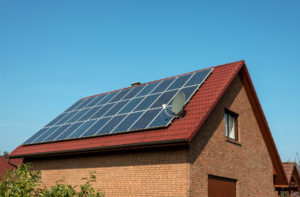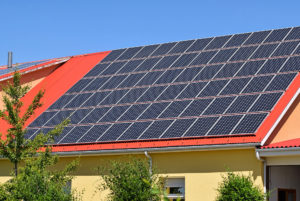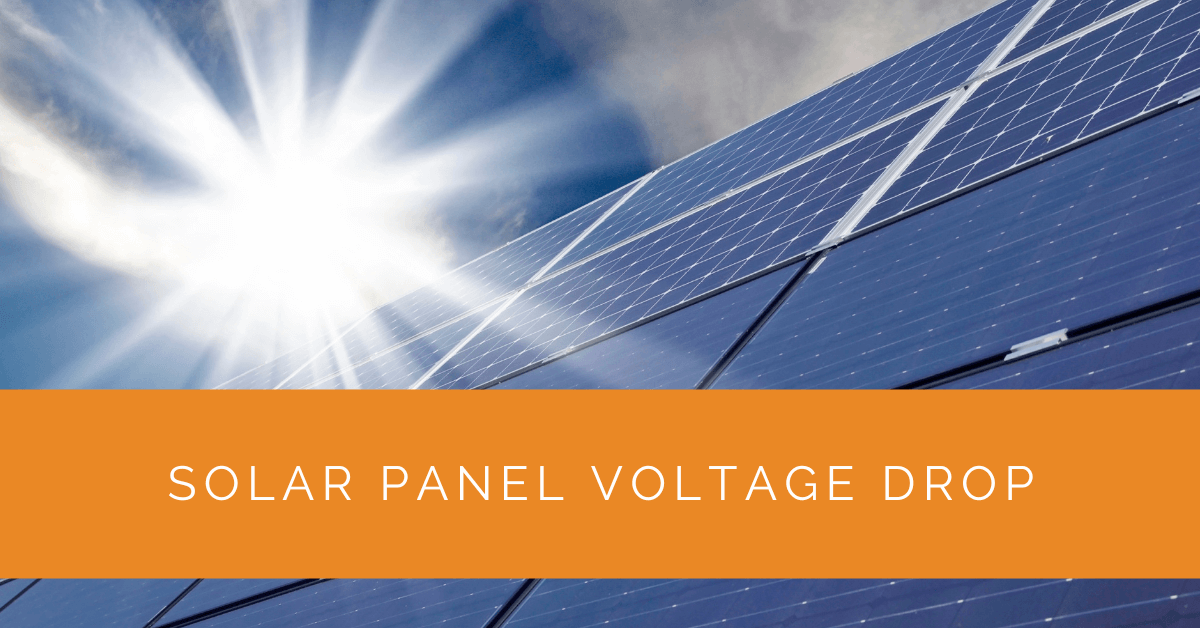Solar panels are the backbone of any photovoltaic (PV) system, converting sunlight into electrical power. However, one critical aspect that often goes unnoticed is voltage drop. This phenomenon can significantly impact your solar system’s efficiency and overall performance. In this comprehensive guide, we will delve deep into the intricacies of solar panel voltage drop and equip you with the knowledge to optimize your system’s output.
Contents
- 1 Key Takeaways
- 2 What is Solar Panel Voltage Drop?
- 3 Factors Contributing to Voltage Drop
- 4 Calculating Voltage Drop
- 5 Minimizing Voltage Drop
- 6 Solar Panel Voltage Drop Calculator
- 7 The Role of MPPT in Managing Voltage
- 8 How Voltage Drop Impacts Solar Inverters
- 9 Calculating How Much Power You Lose
- 10 Case Study: Addressing Solar Panel Voltage Drop in a Residential Installation
- 11 Expert Insights From Our Solar Panel Installers About Understanding Solar Panel Voltage Drop
- 12 Experience Solar Excellence with Us!
- 13 Conclusion
Key Takeaways
- Properly addressing solar panel voltage drop is essential for maximizing the efficiency and performance of your solar system.
- Factors contributing to voltage drop include cable resistance, temperature effects, and wire size, all of which can be managed to minimize losses.
- Utilizing the right cable size, employing proper installation techniques, and leveraging MPPT technology are effective strategies for mitigating voltage drop and optimizing your solar panel system’s output.
What is Solar Panel Voltage Drop?
Voltage is the driving force behind electrical current flow in any circuit, and solar panels are no exception. In a solar panel system, voltage refers to the electrical potential difference generated by the photovoltaic cells. However, as electricity travels from the solar array to the inverter and beyond, it encounters various obstacles, resulting in a voltage drop.
Voltage drop occurs due to factors like the length and size of the cable, temperature effects, and the resistance of the conductive materials. When the voltage drop is excessive, it can significantly reduce the efficiency of your solar system.
Factors Contributing to Voltage Drop
Cable and Wire Resistance
The cables and wires used in a solar system have a natural electrical resistance. As current flows through them, they heat up and dissipate some of the energy as heat. This resistance is directly proportional to the length and inversely proportional to the cross-sectional area of the wire. Longer cables and smaller wire sizes contribute to higher resistance and, consequently, more voltage drop.
Temperature Effects
Temperature can have a substantial impact on voltage drop. As cables heat, their electrical resistance increases, causing greater voltage loss. The opposite can occur in colder climates, but your system design must account for temperature variations.

Calculating Voltage Drop
You can utilize a voltage drop calculator to determine the voltage drop in your solar system accurately. These tools consider various factors, including cable length, wire size, and the expected current flow. By inputting this information, you can gauge the extent of voltage drop and make informed decisions to minimize it.
Minimizing Voltage Drop
Efficient solar panel systems aim to minimize voltage drop to maximize energy output. Here are some strategies to achieve this:
Using the Right Cable Size
Selecting the appropriate cable size based on your system’s current and cable length. Oversized cables can reduce resistance and voltage drop, ensuring efficient power transmission.
Proper Cable Installation Techniques
Install cables correctly, avoiding sharp bends and kinks that could increase resistance. Proper termination and connection techniques also play a significant role in minimizing voltage drop.
Managing Temperature Effects
In extreme temperature conditions, consider cable types that can withstand temperature fluctuations without significant changes in resistance. This ensures consistent performance throughout the year.
Solar Panel Voltage Drop Calculator
Estimate voltage loss in your solar cabling.
The Role of MPPT in Managing Voltage
Maximum Power Point Tracking (MPPT) is a technology in most solar charge controllers and inverters. It plays a pivotal role in mitigating voltage drop effects. MPPT controllers continuously adjust the electrical load on the solar panels to ensure they operate at their maximum power point, minimizing losses due to voltage drop.
How Voltage Drop Impacts Solar Inverters
Solar inverters are responsible for converting the DC power generated by solar panels into AC power for household use. Voltage drop can significantly affect the efficiency and performance of your inverter. Here’s how:
- Efficiency Loss: Voltage drop increases the current, leading to more energy dissipation within the cables and connectors. This results in lower efficiency and reduced energy conversion rates.
- Inverter Sizing: Some users opt for larger inverters to compensate for voltage drops. However, this may not be cost-effective. Properly addressing voltage drop is a more efficient solution.

Calculating How Much Power You Lose
Let’s put things into perspective with an example. Imagine a solar panel system with a peak power output of 10 kW. Due to voltage drop issues, you lose 5% of your power. Over a year, this translates to a significant energy loss and potential savings. Calculating such losses can emphasize the importance of addressing voltage drop.
Case Study: Addressing Solar Panel Voltage Drop in a Residential Installation
Background
A homeowner approached us to install a solar panel system to reduce their electricity bills and contribute to a sustainable future. They wanted a system that maximized energy output and efficiency. We identified that addressing voltage drop would be critical in achieving these goals.
Project Overview
Our objective was to design and install a solar panel system that minimized voltage drop and maximized energy efficiency. We conducted a thorough site assessment and utilized advanced tools to calculate potential voltage drop and devise strategies to mitigate it.
Implementation
- Assessment and Customization: We started by evaluating the property, taking into account the length and size of the cables required for the installation. We used a voltage drop calculator to determine the optimal cable size, considering the expected current flow and distance from the solar array to the inverter.
- Proper Cable Sizing: Using the right cable size was paramount. We selected oversized cables to reduce resistance and minimize voltage drop. This ensured efficient power transmission from the solar panels to the inverter.
- Installation Techniques: Proper installation techniques were crucial in minimizing voltage drop. We avoided sharp bends and kinks in the cables and ensured proper termination and connections. This meticulous approach reduced resistance and potential energy loss.
- Temperature Management: To manage temperature effects, we used cables designed to withstand temperature fluctuations. This ensured consistent performance regardless of weather conditions, preventing significant changes in resistance.
- Leveraging MPPT Technology: We incorporated Maximum Power Point Tracking (MPPT) technology into the solar charge controllers and inverters. MPPT controllers continuously adjusted the electrical load on the solar panels, ensuring they operated at their maximum power point and minimizing voltage drop.
Results
- Efficiency Improvement: By addressing voltage drop through proper cable sizing, installation techniques, and MPPT technology, the solar panel system operated at peak efficiency. The homeowner experienced minimal energy loss and maximum power output.
- Energy Savings: The optimized system significantly reduced energy losses, leading to substantial savings on the homeowner’s electricity bills. The investment in addressing voltage drop paid off quickly through enhanced energy production.
- System Reliability: The use of high-quality cables and proper installation techniques ensured the system’s reliability and longevity. The homeowner enjoyed consistent energy production without the worry of frequent maintenance or performance issues.
- Environmental Impact: By maximizing the efficiency of the solar panel system, the homeowner contributed to a greener future. The optimized system reduced reliance on grid electricity, decreasing their carbon footprint.
Summary
In this residential installation, addressing solar panel voltage drop was key to optimizing system efficiency and performance. Through careful planning, proper cable sizing, and leveraging MPPT technology, we minimized energy losses and maximized power output. The homeowner benefited from significant energy savings and a reliable, high-performing solar panel system. This case study underscores the importance of understanding and addressing voltage drop in solar installations to achieve the best possible outcomes.
Expert Insights From Our Solar Panel Installers About Understanding Solar Panel Voltage Drop
Addressing voltage drop is crucial for optimizing the efficiency of your solar system. Proper cable sizing and installation techniques can make a significant difference in energy loss and overall system performance.
Senior Solar Technician
Utilizing MPPT technology is a game-changer in managing voltage drop. By continuously adjusting the electrical load, MPPT controllers ensure that the solar panels operate at their maximum power point, minimizing energy losses.
Lead Solar Engineer
Understanding the impact of temperature on voltage drop is essential. Using cables that can withstand temperature fluctuations ensures consistent performance and reduces the risk of efficiency loss due to increased resistance.
Solar Installation Manager
Experience Solar Excellence with Us!
Trust in Solar Panels Network USA, where our seasoned experts deliver top-quality solar solutions for homes and businesses nationwide. With a legacy of countless successful installations and a commitment to sustainable energy, we’re your reliable partner in the solar journey. Ready for a brighter, eco-friendly future? Call us now at (855) 427-0058 and harness the power of the sun!
Conclusion
In our experience, understanding and tackling solar panel voltage drop is essential for optimizing the efficiency of your solar system. By considering factors like cable size, installation techniques, and MPPT technology, you can minimize voltage drop and ensure that your solar panels operate at peak performance. Don’t let voltage drop undermine your investment; take the necessary steps to maximize your solar system’s output and energy savings.
By implementing these strategies and staying vigilant about voltage drops, you can enjoy the full benefits of your solar panel system while minimizing energy losses. Remember, a well-optimized solar system benefits your wallet and contributes to a greener, more sustainable future.
About the Author
Solar Panels Network USA stands at the forefront of solar energy solutions, driven by a team of seasoned solar engineers and energy consultants. With over decades of experience in delivering high-quality solar installations and maintenance, we are committed to promoting sustainable energy through customer-centric, tailored solutions. Our articles reflect this commitment, crafted collaboratively by experts to provide accurate, up-to-date insights into solar technology, ensuring our readers are well-informed and empowered in their solar energy decisions.

